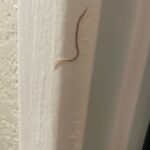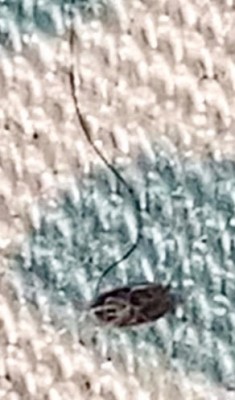
“I keep finding these worms in my bathroom,” writes Chase in his submission regarding the long, thin worm pictured below. “First two times I was in the shower, then by my sink. I see them only on the walls. What are they? I am in Arizona.” The photo is somewhat blurry, so we cannot make out the finer details of the worm’s physical characteristics, but based on what we can see, as well as the fact that it is climbing Chase’s walls, we think this could be a flatworm. Generally speaking, flatworms are predatory creatures. We say generally speaking because there are thousands upon thousands of flatworms species and a good portion of those are parasites. Not to worry, most flatworm parasites cannot survive outside the body of a host, so when someone finds a flatworm in the wild, 99% of the time they will be a predator.
With that said, predatory flatworms can still do some minuscule harm to humans. They can secrete a toxin which is fatal to smaller creatures but which causes mild pain and/or irritation to bigger animals like humans. We just recommend avoiding physical contact with flatworms. So, if this flatworm is predatory, why would it be crawling up Chase’s walls? And why are there so many of them (assuming Chase is moving the worms outside as he finds them and not rediscovering the same worm over and over in his home)? Our guess is that there is a batch of flatworm eggs somewhere inside or near Chase’s home, and now the eggs have begun hatching, thereby spawning all of these flatworms. Since all of the worms have been found near drains so far, we think this is the most likely place for them to be coming from.
It is important to keep one’s drains clean, so as to prevent the build-up of organic matter that will then decompose and attract certain critters. Now, decomposing organic matter is not attractive to flatworms, per se, but it will attract other organisms that the flatworms may have been hunting in the sewers (lovely image isn’t it?). Bathrooms that are not often used (for example, guest bathrooms) are especially prone to getting visits from unwelcome creatures, as the lack of flow of water down the drains lets things grow on the stagnant water: an inviting habitat for many small creatures. With all of that said, it could also be that the flatworms did not come from the drains because Chase has an infestation of something else, but because the mother flatworm found her way into Chase’s home (maybe chasing a rogue bug) and laid her eggs in this spot. As the eggs hatch, the flatworms have been trying to flee in search of food, hence why they are climbing the walls (a similar behavior displayed in earthworms looking for a new habitat).
To conclude, we think it is possible that Chase has been finding flatworms in his bathroom, though it is hard to say with certainty given the poor resolution of the photo. In any case, we recommend that Chase avoid making physical contact with the worms, move them outside on a dustpan (or something else which Chase can keep away from his body), and regularly clean his drains out. We hope this helps, and we wish Chase the very best.
All About Worms is always free, always reader-supported. Your tips via CashApp, Venmo, or Paypal are appreciated! Receipts will come from ISIPP Publishing.
You might also find these guys interesting!

















